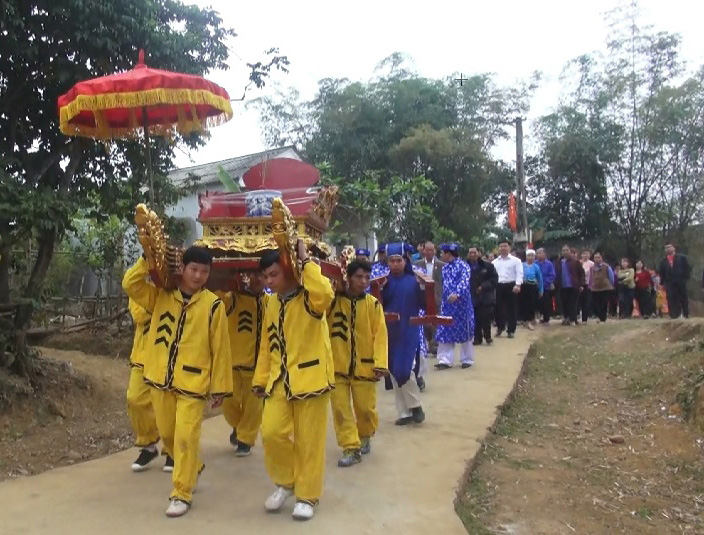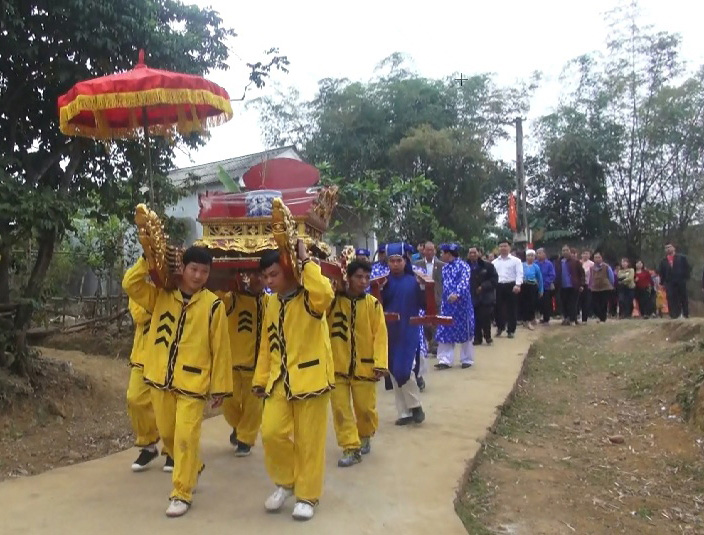



A palanquin procession from Ca shrine in Dong
Ngoai commune to Dung Phong commune’s stadium was revived during the Khai mua
Festival at the Khai mua Muong Thang festival 2018.
Chairman of the People’s Committee of Dung
Phong commune Bui Van Lien said that the Khai mua Muong Thang festival was
first revived in 2013 but at commune-level. In 2017, the district planned to
organise the festival at district-level, which received warm response from
local residents. The festival drew the participation of thousands of local
people as well as visitors from other districts, proving the event’s
attractiveness.
Looking back, the Khai mua Muong Thang festival
was similar to the Xuong dong/Khuong dong (ploughing ceremony) of the Muong
minority group. It holds significant meaning to the people’s material and
spiritual lives.
At the festival, people pay respect and
express their gratitude to Gods of the Tan Vien mountain, who protect and help
Muong people to have a prosperous and happy life. The festival also honours the
Village Tutelary, the Kitchen God and the Land God. It is an occasion to review
the previous year and start a new production period. Through the festival,
people get closer together and tighten solidarity.
In early spring annually, people in Dong
Ngoai village of Dung Phong commune prepare for the festival in a large field.
15 days prior to the festival, the village and fields must be cleaned. There
must be a person in charge in order to organise a grand festival. In the past,
the commune’s Lang cun (head of the commune) raised money or assigned his
subordinates to hold the festival. The preparation of the festival was directed
by the Lang cun. Besides, a shaman was appointed to take charge of the
worshipping ritual. Local people made preparations such as assigning persons
and prepare costumes and offerings for the ritual. The worshipping ritual
usually took place during two days, followed by festive activities.
In the old days, the entertainment at the
festival featured "vi” and "dum” singing, gong performance, musket shooting
contest, wrestling, "con” (colourful fabric ball) throwing, swinging, and
other folk games.
The festival was not organised from 1946 to
2012. It was held at communal level from
2013 to 2017. Quach Van Ngoan, Vice Chairman of the Cao Phong district People’s
Committee, Head of the organisation board of festival said, the revival of the festival
meets the expectation of authorities and people of Muong Thang. The district
has cooperated with the provincial Department of Culture, Sports and Tourism to
study and revive the traditional rituals. The Khai mua Muong Thang festival was
held at district level this year with the aim to restore and preserve the
traditional culture and folk games and traditional sports. It also aims to meet
the cultural and spiritual needs of local residents, and popularise the
cultural identity of Dung Phong commune in particular and Muong Thang area in general.
The festival represents the culture of the four big Muong ethnic communities in
the province to lure tourists and develop local tourism.
The praying ritual took place at Muong Thang
Ca Temple in Dong Ngoai commune in the afternoon of the 5th day of
the first lunar month, worshipping the three Mountain Gods, the Tutelary God,
the Kitchen God and Land God.
In the morning of the 6th day of lunar month,
besides the ritual in Dong Ngoai commune, another ritual is performed at the
tomb of a Le dynasty’s princess in Xuong Dau hamlet of Dung Phong commune. The
villages’ offerings were placed on trays supported by three cross-tied yokes.
Family offerings were placed on mats in front of the temple. The shaman lit
incense and asked for the gods’ permission to forecast future through the feet
of the offered chicken.
The water procession ceremony followed the
ritual, bringing water from the sacred well to the temple to pray for clean,
fresh and smooth life, health, and good crop. The shaman splashed the scared
water over things around.
Then it came the Tutelary God worshipping,
featuring palanquin procession from Muong Thang Ca Temple to the stadium in
Dung Phong commune. In the silence after the drum beats and gong dance, the
shaman read out loud the announcement to launch the festival in Muong ethnic
language.
The traditional rituals were followed by a
State ceremony and an art performance, involving 200 gong dancers, reviving the
history and legend of the festival, and introducing Cao Phong products. After
the ceremony, the palanquin procession began.
The festive activities included vi, dum
singing competitions, gong dances, Con throwing, bag jumping, basket making
competition. Communes sent their amateur artists to perform songs and dances
and traditional costume shows.
Every villager was excited with the
festival’s activities and atmosphere, particularly the elderly in Dung Phong
commune, like Bui Van Oi, or Bui Thanh Meo, and Chairman of the communal
People’s Committee Bui Van Lien. The festive atmosphere gave all Muong Thang
people and visitors joy and confidence in a new year of good luck./.